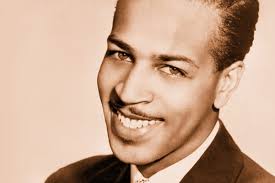Wynonie Harris – A Complete Biography
Introduction
Wynonie Harris was a flamboyant and charismatic blues shouter whose high-energy performances and risqué lyrics left a lasting impact on American music. Known for his magnetic stage presence and powerful voice, Harris became a central figure in the jump blues and rhythm and blues scenes of the 1940s and early 1950s. He was instrumental in paving the way for the emergence of rock and roll, influencing a generation of performers who followed in his wake.

Childhood
Wynonie Harris was born on August 24, 1915, in Omaha, Nebraska. His mother, Mallie Hood Anderson, was a teenager at the time of his birth, and Wynonie grew up without a consistent father figure. He was later raised by his mother and stepfather, Luther Harris, from whom he took his surname. Life in Omaha during Harris’s early years was challenging, but his natural charisma and talent became apparent from a young age.
Youth
As a teenager, Harris attended high school in North Omaha but dropped out at the age of 16. He became a father twice before the age of 18 and began supporting himself through performing. Harris initially worked as a dancer and entertainer, forming a nightclub act with a partner named Velda Shannon. His performances in local theaters and clubs helped him develop a bold, confident stage presence that would become his trademark.
During the early 1930s, Harris focused on building a career in entertainment. He gained recognition in Omaha’s music circuit and soon realized his voice held great commercial potential. His blend of humor, bravado, and vocal power made him a popular figure in the city’s nightlife.
Adulthood
By the late 1930s, Harris moved to Los Angeles to pursue broader opportunities. He performed in nightclubs along Central Avenue, quickly earning the nickname “Mr. Blues” for his rousing interpretations of blues standards and original compositions. His confident, often provocative performances attracted large crowds and the attention of music promoters.
In 1944, Harris joined Lucky Millinder’s orchestra as a featured vocalist. His first major success came with the hit “Who Threw the Whiskey in the Well,” which brought him national attention. Following this breakthrough, Harris launched a solo career and signed with several prominent record labels over the years, including Philo, Apollo, and King Records.
His recordings throughout the late 1940s and early 1950s made him one of the most popular R&B artists in the country. Harris was known not only for his music but also for his stylish wardrobe, exuberant personality, and stage antics. He toured extensively, playing to sold-out audiences and helping to popularize jump blues—a swinging, up-tempo style that bridged big band jazz and early rock and roll.
Major Compositions
Wynonie Harris’s discography includes several songs that became classics of the jump blues and early R&B eras. One of his most iconic hits was “Good Rockin’ Tonight,” a high-energy track that exemplified his vigorous style and playful lyricism. The song was later covered by numerous artists and is often cited as a precursor to rock and roll.
Other standout songs include:
- “Drinkin’ Wine Spo-Dee-O-Dee” – a raucous drinking anthem that became a fan favorite.
- “Lovin’ Machine” – a humorous, sexually charged tune that showcased Harris’s bold lyrical approach.
- “Bloodshot Eyes” – a blend of blues and country elements that displayed his stylistic versatility.
- “Keep On Churnin’ (Till the Butter Comes)”, “Lollipop Mama”, and “Sittin’ on It All the Time” – all of which pushed boundaries with their suggestive themes and upbeat rhythms.
These songs exemplified Harris’s unique ability to blend humor, rhythm, and showmanship into unforgettable performances.
Death
As musical tastes shifted in the mid-1950s, Harris’s popularity declined. The rise of younger rock and roll stars led to fewer recording opportunities, and his public visibility diminished. Despite continued efforts to perform and record, Harris struggled with health and financial issues.
In the 1960s, he was diagnosed with throat cancer. His final years were marked by declining health, and he passed away on June 14, 1969, in Los Angeles at the age of 53. His death marked the end of a dynamic and influential career that helped shape the course of American music.
Conclusion
Wynonie Harris was more than just a blues shouter—he was a trailblazer whose bold musical style and electrifying performances helped bridge the gap between rhythm and blues and rock and roll. His legacy is evident in the work of countless artists who followed, from early rock pioneers to modern performers. Although his name may not be as widely recognized as some of his contemporaries, his contributions to music remain undeniable. Harris’s voice, energy, and fearless approach continue to inspire musicians and fans around the world.

Comments are closed